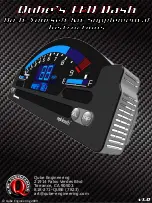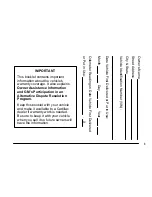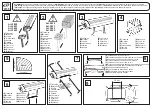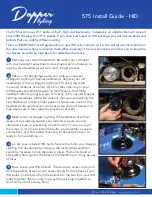
ment of excess or free electrons between the positive
and negative plate groups. This movement of elec-
trons produces a flow of electrical current through
the load device attached to the battery terminals.
As the plate materials become more similar chem-
ically, and the electrolyte becomes less acid, the volt-
age potential of each cell is reduced. However, by
charging the battery with a voltage higher than that
of the battery itself, the battery discharging process
is reversed. Charging the battery gradually changes
the sulfated lead plates back into sponge lead and
lead dioxide, and the water back into sulfuric acid.
This action restores the difference in the electron
charges deposited on the plates, and the voltage
potential of the battery cells. For a battery to remain
useful, it must be able to produce high-amperage cur-
rent over an extended period. A battery must also be
able to accept a charge, so that its voltage potential
may be restored.
The battery is vented to release excess hydrogen
gas that is created when the battery is being charged
or discharged. However, even with these vents,
hydrogen gas can collect in or around the battery. If
hydrogen gas is exposed to flame or sparks, it may
ignite. If the electrolyte level is low, the battery may
arc internally and explode. If the battery is equipped
with removable cell caps, add distilled water when-
ever the electrolyte level is below the top of the
plates. If the battery cell caps cannot be removed, the
battery must be replaced if the electrolyte level
becomes low.
In addition to producing and storing electrical
energy, the battery serves as a capacitor and voltage
stabilizer for the electrical system of the vehicle. It
absorbs most abnormal or transient voltages caused
by the switching of any of the electrical components
in the vehicle.
BATTERY CABLES
DESCRIPTION
The battery cables (Fig. 2) are large gauge,
stranded copper wires sheathed within a heavy plas-
tic or synthetic rubber insulating jacket. The wire
used in the battery cables combines excellent flexibil-
ity and reliability with high electrical current carry-
ing capacity. Refer to Wiring Diagrams in the index
of this service manual for the location of the proper
battery cable wire gauge information.
A clamping type female battery terminal made of
soft lead is die cast onto one end of the battery cable
wire. A square headed pinch-bolt and hex nut are
installed at the open end of the female battery termi-
nal clamp. Large eyelet type terminals are crimped
onto the opposite end of the battery cable wire and
then solder-dipped. The battery positive cable wires
have a red insulating jacket to provide visual identi-
fication and features a larger female battery terminal
clamp to allow connection to the larger battery posi-
tive terminal post. The battery negative cable wires
have a black insulating jacket and a smaller female
battery terminal clamp.
The battery cables cannot be repaired and, if dam-
aged or faulty they must be replaced. Both the bat-
tery positive and negative cables are available for
service replacement only as a unit with the battery
wire harness, which may include portions of the wir-
ing circuits for the generator and other components
on some models. Refer to Wiring Diagrams in the
index of this service manual for the location of more
information on the various wiring circuits included in
the battery wire harness for the vehicle being ser-
viced.
OPERATION
The battery cables connect the battery terminal
posts to the vehicle electrical system. These cables
also provide a return path for electrical current gen-
erated by the charging system for restoring the volt-
age potential of the battery. The female battery
terminal clamps on the ends of the battery cable
wires provide a strong and reliable connection of the
battery cable to the battery terminal posts. The ter-
minal pinch bolts allow the female terminal clamps
to be tightened around the male terminal posts on
the top of the battery. The eyelet terminals secured
to the ends of the battery cable wires opposite the
female battery terminal clamps provide secure and
Fig. 2 Battery Cables
1 – BATTERY
2 – RADIATOR CROSSMEMBER
3 – TERMINAL CLAMPS
4 – FENDER INNER SHIELD
5 – NEGATIVE CABLE
6 – POSITIVE CABLE
XJ
BATTERY
8A - 3
DESCRIPTION AND OPERATION (Continued)
Summary of Contents for 200 Cherokee
Page 5: ...FASTENER IDENTIFICATION 4 INTRODUCTION XJ DESCRIPTION AND OPERATION Continued ...
Page 6: ...FASTENER STRENGTH XJ INTRODUCTION 5 DESCRIPTION AND OPERATION Continued ...
Page 8: ...METRIC CONVERSION CHART XJ INTRODUCTION 7 DESCRIPTION AND OPERATION Continued ...
Page 9: ...TORQUE SPECIFICATIONS 8 INTRODUCTION XJ DESCRIPTION AND OPERATION Continued ...
Page 47: ......
Page 107: ...Fig 105 Gear Tooth Contact Patterns 3 60 TUBE 181 AND 186 FBI AXLE XJ ADJUSTMENTS Continued ...
Page 111: ...Installer D 144 Installer W 262 3 64 TUBE 181 AND 186 FBI AXLE XJ SPECIAL TOOLS Continued ...
Page 145: ...Fig 79 Gear Tooth Contact Patterns 3 98 194 RBI AXLE XJ ADJUSTMENTS Continued ...
Page 177: ...Fig 59 Gear Tooth Contact Patterns 3 130 8 1 4 REAR AXLE XJ ADJUSTMENTS Continued ...
Page 230: ...Fig 8 Clutch Components And Inspection XJ CLUTCH 6 5 DIAGNOSIS AND TESTING Continued ...
Page 241: ......
Page 357: ......
Page 367: ......
Page 449: ......
Page 451: ......
Page 475: ......
Page 484: ...SPECIAL TOOLS HEADLAMP ALIGNMENT Headlamp Aiming Kit C 4466 A XJ LAMPS 8L 9 ...
Page 507: ......
Page 537: ......
Page 551: ......
Page 571: ......
Page 577: ......
Page 583: ......
Page 613: ......
Page 615: ......
Page 631: ......
Page 669: ......
Page 707: ......
Page 735: ......
Page 783: ......
Page 789: ......
Page 805: ......
Page 823: ......
Page 827: ......
Page 851: ......
Page 863: ......
Page 867: ......
Page 893: ......
Page 921: ......
Page 925: ......
Page 931: ......
Page 937: ......
Page 1047: ......
Page 1072: ...Fig 16 2 5L Engine XJ 8W 90 CONNECTOR LOCATIONS 8W 90 25 DESCRIPTION AND OPERATION Continued ...
Page 1073: ...Fig 17 4 0L Engine 8W 90 26 8W 90 CONNECTOR LOCATIONS XJ DESCRIPTION AND OPERATION Continued ...
Page 1074: ...Fig 18 4 0L Engine XJ 8W 90 CONNECTOR LOCATIONS 8W 90 27 DESCRIPTION AND OPERATION Continued ...
Page 1087: ...Fig 31 Liftgate 8W 90 40 8W 90 CONNECTOR LOCATIONS XJ DESCRIPTION AND OPERATION Continued ...
Page 1099: ......
Page 1129: ......
Page 1249: ......
Page 1331: ...Fig 6 Frame Dimensions 13 8 FRAME AND BUMPERS XJ SPECIFICATIONS Continued ...
Page 1333: ......
Page 1335: ......
Page 1869: ......
Page 1875: ......
Page 1887: ......
Page 1912: ...Fig 3 Hood Components XJ BODY 23 25 REMOVAL AND INSTALLATION Continued ...
Page 1955: ...WELD LOCATIONS UPPER COWL 23 68 BODY XJ SPECIFICATIONS Continued ...
Page 1956: ...UPPER COWL XJ BODY 23 69 SPECIFICATIONS Continued ...
Page 1957: ...COWL 23 70 BODY XJ SPECIFICATIONS Continued ...
Page 1958: ...A PILLAR XJ BODY 23 71 SPECIFICATIONS Continued ...
Page 1959: ...A PILLAR 23 72 BODY XJ SPECIFICATIONS Continued ...
Page 1960: ...A PILLAR XJ BODY 23 73 SPECIFICATIONS Continued ...
Page 1961: ...A PILLAR 23 74 BODY XJ SPECIFICATIONS Continued ...
Page 1962: ...B PILLAR XJ BODY 23 75 SPECIFICATIONS Continued ...
Page 1963: ...D PILLAR 23 76 BODY XJ SPECIFICATIONS Continued ...
Page 1964: ...FUEL FILLER OPENING XJ BODY 23 77 SPECIFICATIONS Continued ...
Page 1965: ...CARGO AREA FLOOR PAN 23 78 BODY XJ SPECIFICATIONS Continued ...
Page 1966: ...ROOF AND D PILLAR XJ BODY 23 79 SPECIFICATIONS Continued ...
Page 1967: ...LIFTGATE OPENING 23 80 BODY XJ SPECIFICATIONS Continued ...
Page 1968: ...ROOF XJ BODY 23 81 SPECIFICATIONS Continued ...
Page 1969: ...ROOF 23 82 BODY XJ SPECIFICATIONS Continued ...
Page 1970: ...FRAME RAIL XJ BODY 23 83 SPECIFICATIONS Continued ...
Page 1971: ...FRAME RAIL 23 84 BODY XJ SPECIFICATIONS Continued ...
Page 1972: ...FRAME RAIL XJ BODY 23 85 SPECIFICATIONS Continued ...
Page 1973: ...FRAME RAIL 23 86 BODY XJ SPECIFICATIONS Continued ...
Page 1974: ...REINFORCEMENT XJ BODY 23 87 SPECIFICATIONS Continued ...
Page 1975: ...FRONT INNER FENDER 23 88 BODY XJ SPECIFICATIONS Continued ...
Page 1976: ...FRONT INNER FENDER AND RADIATOR CLOSURE PANEL XJ BODY 23 89 SPECIFICATIONS Continued ...
Page 1977: ...REINFORCEMENT 23 90 BODY XJ SPECIFICATIONS Continued ...
Page 1978: ...FRONT FENDER XJ BODY 23 91 SPECIFICATIONS Continued ...
Page 1979: ...BODY SIDE 23 92 BODY XJ SPECIFICATIONS Continued ...
Page 1980: ...REAR WHEELHOUSE XJ BODY 23 93 SPECIFICATIONS Continued ...
Page 1981: ...REAR INNER WHEELHOUSE 23 94 BODY XJ SPECIFICATIONS Continued ...
Page 1982: ...BODY SIDE XJ BODY 23 95 SPECIFICATIONS Continued ...
Page 1983: ...BODY SIDE 23 96 BODY XJ SPECIFICATIONS Continued ...
Page 1984: ...BODY SIDE XJ BODY 23 97 SPECIFICATIONS Continued ...
Page 1985: ...BODY SIDE 23 98 BODY XJ SPECIFICATIONS Continued ...
Page 1986: ...BODY SIDE XJ BODY 23 99 SPECIFICATIONS Continued ...
Page 1987: ...BODY SIDE 23 100 BODY XJ SPECIFICATIONS Continued ...
Page 1988: ...UNDERBODY XJ BODY 23 101 SPECIFICATIONS Continued ...
Page 1989: ...UNDERBODY 23 102 BODY XJ SPECIFICATIONS Continued ...
Page 1990: ...UNDERBODY XJ BODY 23 103 SPECIFICATIONS Continued ...
Page 1991: ...UNDERBODY 23 104 BODY XJ SPECIFICATIONS Continued ...
Page 1992: ...UNDERBODY XJ BODY 23 105 SPECIFICATIONS Continued ...
Page 1993: ...UNDERBODY 23 106 BODY XJ SPECIFICATIONS Continued ...
Page 1994: ...UNDERBODY XJ BODY 23 107 SPECIFICATIONS Continued ...
Page 1995: ...UNDERBODY 23 108 BODY XJ SPECIFICATIONS Continued ...
Page 1996: ...UNDERBODY XJ BODY 23 109 SPECIFICATIONS Continued ...
Page 1997: ...UNDERBODY 23 110 BODY XJ SPECIFICATIONS Continued ...
Page 1998: ...UNDERBODY XJ BODY 23 111 SPECIFICATIONS Continued ...
Page 1999: ...BODY SEALING LOCATIONS APPLICATION METHODS 23 112 BODY XJ SPECIFICATIONS Continued ...
Page 2000: ...COWL AND DASH PANEL XJ BODY 23 113 SPECIFICATIONS Continued ...
Page 2001: ...DASH PANEL AND FLOOR PAN 23 114 BODY XJ SPECIFICATIONS Continued ...
Page 2002: ...FLOOR PAN XJ BODY 23 115 SPECIFICATIONS Continued ...
Page 2003: ...REAR INNER WHEELHOUSE 23 116 BODY XJ SPECIFICATIONS Continued ...
Page 2004: ...FRONT INNER WHEELHOUSE XJ BODY 23 117 SPECIFICATIONS Continued ...
Page 2005: ...BODY SIDE 23 118 BODY XJ SPECIFICATIONS Continued ...
Page 2006: ...BODY SIDE XJ BODY 23 119 SPECIFICATIONS Continued ...
Page 2007: ...BODY SIDE 23 120 BODY XJ SPECIFICATIONS Continued ...
Page 2008: ...ROOF PANEL XJ BODY 23 121 SPECIFICATIONS Continued ...
Page 2009: ...FUEL FILLER HOUSING 23 122 BODY XJ SPECIFICATIONS Continued ...
Page 2010: ...LIFTGATE OPENING XJ BODY 23 123 SPECIFICATIONS Continued ...
Page 2011: ...STRUCTURAL ADHESIVE LOCATIONS LEFT QUARTER PANEL 23 124 BODY XJ SPECIFICATIONS Continued ...
Page 2012: ...REAR WHEELHOUSE XJ BODY 23 125 SPECIFICATIONS Continued ...
Page 2013: ...ROOF BOWS 23 126 BODY XJ SPECIFICATIONS Continued ...
Page 2023: ......
Page 2071: ......
















































